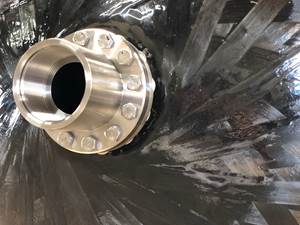Farnborough Airshow Report 2006
The biggest and busiest in recent memory, this year's event puts an unprecedented spotlight on composites.
The Farnborough International Airshow, held July 13-23 in Farn- borough, U.K., was one of the biggest in recent memory, with major new product and program launches. The show's 1,480 exhibitors from 35 countries conducted more than $42 billion (USD) of business.
Show visitors included British Prime Minister Tony Blair and some 75 defense delegations and 40 civil aerospace contingents from a total of 58 countries. Attendance figures exceeded 133,000.
Although Airbus Industrie's (Toulouse, France) new A380 passenger jet continued to impress media and visitors alike with its size - on the ground and in the air - it was the aircraft manufacturer's mid-size, twin-aisle A350 that attracted the greatest attention. There was much preshow speculation about what Airbus officials might announce in regard to its troubled program and the related management upheavals at Airbus and parent company EADS. Airbus did not disappoint. Its new CEO, Christian Streiff, made a very good impression as a man who understands the need to restore the customer's confidence in Airbus. In particular, he was not going to be rushed into fully launching the new version A350 until he was sure it was the right aircraft - a decision for a formal industrial launch is anticipated in October. What he did promise is that it will be "Best in Class"when the design is complete. Airbus claims that the renamed A350 XWB (Xtra-Wide Body) equals or betters the 787 Dreamliner from arch-rival The Boeing Co. (Seattle, Wash.) in all important performance areas. The A350 XWB's all-composite wing design increases the sweep of the original A350's wing by 3°, from 30° to 33°, enabling the plane's cruise speed to be increased to Mach 0.85. Airbus VP of programs Tom Williams emphasized that the delay had the benefit of allowing Airbus to look at alternative materials and processes since the decision to use prepreg was being reevaluated for some wing parts.
Airbus talked about increasing composites use in the fuselage but would not elaborate. However, the company did reveal that the XWB's fuselage diameter will be 300 mm/12 inches greater than on the earlier design - about 100 mm/4 inches wider than the 787 at passenger shoulder height. Additionally, passenger cabin comfort will be increased, with a pressure equivalent to an altitude of 2,000m/6,000 ft, 20 percent humidity and the widest windows ever on a modern aircraft. Airbus also claimed a small but significant 2 to 7 percent improvement in operating cost, compared with the 787. Most impressive, however, were comparisons with the previous-generation Boeing 777: both the 350 XWB and 787 are expected to reduce per-seat fuel consumption by 26 to 30 percent.
Boeing, meanwhile, displayed quiet confidence in its 787 program, reporting that the plane's first wing was being assembled. Previous reports of a poor-quality fuselage barrel test specimen were dismissed as a normal development event, caused by a new composite mandrel that leaked under vacuum in just one of the nine barrels made for the test program. Boeing says the program will not be delayed because testing will be split to allow fabrication of a replacement mandrel, using an alter-native resin system. Although the popular media tried to make a big issue of this "failure,"this composites engineer found Boeing's explanation very plausible - in fact, rather familiar. Of more interest to the better-informed trade press was Boeing 787 program general manager Mike Bair's statement that the company intends to increase composites use on the 787 from 50 to 51 or 52 percent. In particular, he believed they now can make cost-effective carbon fiber ribs. It had previously been difficult to replace metal ribs with composites because the latter required a much larger radius in the right-angle bend on the attachment flange. (Composites do not take loads as effectively as metals around sharp bends.) The result had been a wider, heavier flange that placed rivets further from the bend, increasing the loads.
Related Content
Plant tour: Aernnova Composites, Toledo and Illescas, Spain
RTM and ATL/AFP high-rate production sites feature this composites and engineering leader’s continued push for excellence and innovation for future airframes.
Read MoreInfinite Composites: Type V tanks for space, hydrogen, automotive and more
After a decade of proving its linerless, weight-saving composite tanks with NASA and more than 30 aerospace companies, this CryoSphere pioneer is scaling for growth in commercial space and sustainable transportation on Earth.
Read MoreDevelopment of a composite liquid hydrogen tank for commercial aircraft
Netherlands consortium advances cryogenic composites testing, tank designs and manufacturing including AFP, hybrid winding, welding of tank components and integrated SHM and H2 sensors for demonstrators in 2025.
Read MoreOtto Aviation launches Phantom 3500 business jet with all-composite airframe from Leonardo
Promising 60% less fuel burn and 90% less emissions using SAF, the super-laminar flow design with windowless fuselage will be built using RTM in Florida facility with certification slated for 2030.
Read MoreRead Next
Next-gen fan blades: Hybrid twin RTM, printed sensors, laser shock disassembly
MORPHO project demonstrates blade with 20% faster RTM cure cycle, uses AI-based monitoring for improved maintenance/life cycle management and proves laser shock disassembly for recycling.
Read MoreCeramic matrix composites: Faster, cheaper, higher temperature
New players proliferate, increasing CMC materials and manufacturing capacity, novel processes and automation to meet demand for higher part volumes and performance.
Read MoreCutting 100 pounds, certification time for the X-59 nose cone
Swift Engineering used HyperX software to remove 100 pounds from 38-foot graphite/epoxy cored nose cone for X-59 supersonic aircraft.
Read More











